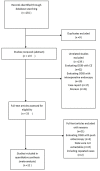Clinical Outcomes of Negative Balloon-Assisted Enteroscopy for Obscure Gastrointestinal Bleeding: A Systematic Review and Meta-Analysis
- PMID: 35308514
- PMCID: PMC8931682
- DOI: 10.3389/fmed.2022.772954
Clinical Outcomes of Negative Balloon-Assisted Enteroscopy for Obscure Gastrointestinal Bleeding: A Systematic Review and Meta-Analysis
Abstract
Background: For patients with obscure gastrointestinal bleeding (OGIB), finding the bleeding site is challenging. Balloon-assisted enteroscopy (BAE) has become the preferred diagnostic modality for OGIB. The long-term outcome of patients with negative BAE remains undefined. The present study aimed to evaluate the long-term outcomes of patients with negative BAE results for OGIB and to clarify the effect of further investigations at the time of rebleeding with a systematic review and meta-analysis of the available cohort studies.
Methods: Studies were searched through the PubMed, EMBASE, and Cochrane library databases. The following indexes were analyzed: rebleeding rate after negative BAE, rebleeding rate after different follow-up periods, the proportion of patients who underwent further evaluation after rebleeding, the percentage of patients with identified rebleeding sources, and the percentage of patients with rebleeding sources in the small intestine. Heterogeneity was assessed using the I2 test.
Results: Twelve studies that involved a total of 407 patients were included in the analysis. The pooled rebleeding rate after negative BAE for OGIB was 29.1% (95% CI: 17.2-42.6%). Heterogeneity was significant among the studies (I2 = 88%; p < 0.0001). The Chi-squared test did not show a difference in rebleeding rates between the short and long follow-up period groups (p = 0.142). The pooled proportion of patients who underwent further evaluation after rebleeding was 86.1%. Among the patients who underwent further evaluation, rebleeding sources were identified in 73.6% of patients, and 68.8% of the identified rebleeding lesions were in the small intestine.
Conclusion: A negative result of BAE in patients with OGIB indicates a subsequently low risk of rebleeding. Further evaluation should be considered after rebleeding.
Keywords: enteroscopy; follow-up; obscure gastrointestinal bleeding; rebleeding; small intestine.
Copyright © 2022 Shao, Shao, Wang, Zhang and Tian.
Conflict of interest statement
The authors declare that the research was conducted in the absence of any commercial or financial relationships that could be construed as a potential conflict of interest.
Figures




Similar articles
-
Does urgent balloon-assisted enteroscopy impact rebleeding and short-term mortality in overt obscure gastrointestinal bleeding?Scand J Gastroenterol. 2020 Oct;55(10):1243-1247. doi: 10.1080/00365521.2020.1813800. Epub 2020 Sep 10. Scand J Gastroenterol. 2020. PMID: 32907435
-
Etiology and long-term rebleeding of endoscopic ulcerative lesions in the small bowel in patients with obscure gastrointestinal bleeding: A multicenter cohort study.J Gastroenterol Hepatol. 2018 Jul;33(7):1327-1334. doi: 10.1111/jgh.14068. Epub 2018 Feb 27. J Gastroenterol Hepatol. 2018. PMID: 29231993
-
Video capsule endoscopy in overt and occult obscure gastrointestinal bleeding: Insights from a single-center, observational study in Japan.DEN Open. 2024 Apr 1;4(1):e354. doi: 10.1002/deo2.354. eCollection 2024 Apr. DEN Open. 2024. PMID: 38567032 Free PMC article.
-
Small bowel capsule endoscopy in obscure gastrointestinal bleeding: normalcy is not reassuring.Eur J Gastroenterol Hepatol. 2014 Aug;26(8):927-32. doi: 10.1097/MEG.0000000000000135. Eur J Gastroenterol Hepatol. 2014. PMID: 24922357 Review.
-
Timing of enteroscopy in overt-obscure gastrointestinal bleeding: a systematic review and meta-analysis.Rev Esp Enferm Dig. 2021 Sep;113(9):656-669. doi: 10.17235/reed.2021.7976/2021. Rev Esp Enferm Dig. 2021. PMID: 34058827
References
-
- Longstreth GF. Epidemiology and outcome of patients hospitalized with acute lower gastrointestinal hemorrhage: a population based study. Am J Gastroenterol. (1997) 92:419–24. - PubMed
Publication types
LinkOut - more resources
Full Text Sources

